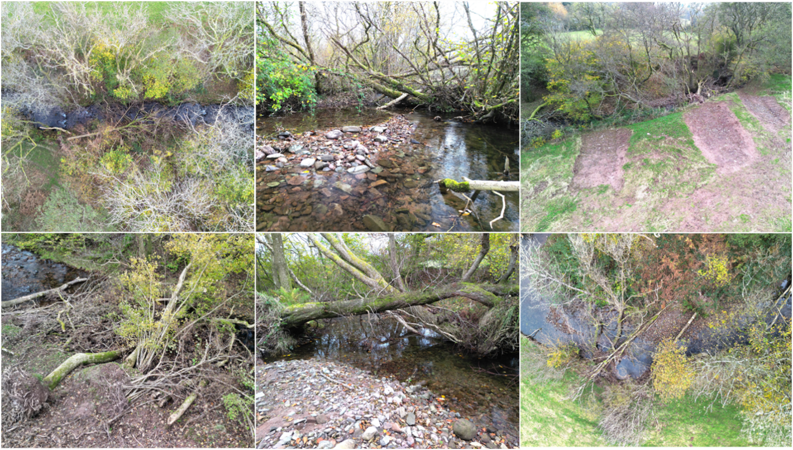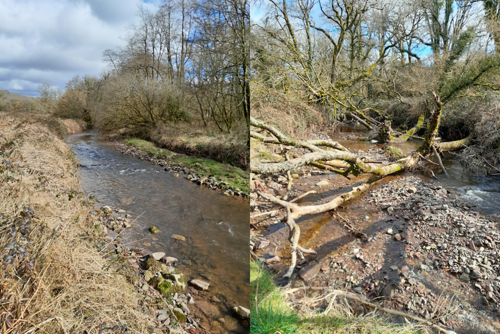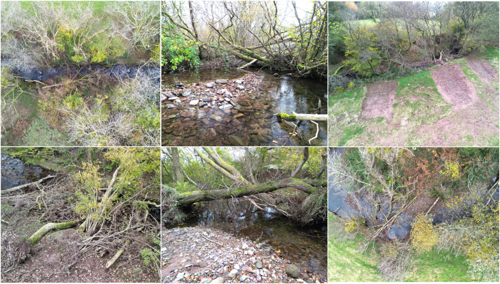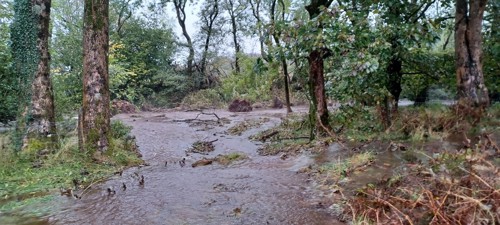How wood is helping to restore river habitat

The Four Rivers for LIFE project aims to improve the habitat structure and function of four SAC Rivers; the Teifi, Tywi, Cleddau and Usk.
On the River Usk, Project Officers have been working with the National Trust at their Ty Mawr Farm estate in the Brecon Beacons to restore the river and reconnect it to its natural floodplain by reintroducing wood into the river.
In this blog, Four Rivers for LIFE River Restoration Officer, Peter Jones, explains how they’ve done this and the importance of this work.
Controlling our rivers
One of the most widespread challenges to river habitats in the UK is that they have been altered to reduce their natural dynamism and keep them confined to their channels.
Traditional management of rivers involved regular ‘stream cleaning’ to completely remove wood from the channel. In combination with a regime of land drainage and river engineering, by the 1980s the majority of our rivers and streams were managed into deeper, straighter, single channels (taken from Woody Debris Booklet).
Over the past 40 years, research into the subject of wood in rivers now shows us that it is a vital component of a healthy functioning river ecosystem, creating a diverse structure and important habitat for the wildlife it supports.
A key element of river dynamics is the amount of in-stream wood (fallen trees, branches, etc), which would have been historically abundant in most rivers but has become increasingly rare.
Leaving fallen trees (where it doesn’t pose a flood risk to property) in the river channel can help rivers recover, as woody debris acts as a catalyst to trap gravels and silts, raise bed levels, and help create different flow patterns.
Naturally functioning rivers should regularly inundate their floodplains, increasing wetland habitat locally and reducing overall flood risk downstream.
The value of wood and large trees in rivers
Large woody material plays a wide range of important functional roles in river ecosystems, and is increasingly recognised as one of the fundamental components of a healthy river system, alongside sediment and water supply.
Woody material creates localised patches of erosion and deposition, thereby increasing habitat diversity (see below image).

Above image: Example of the effect of large wood on habitat diversity. This is the same river, only a couple of hundred metres apart, one reach in the presence of large wood, the other without (credit NRW).
Wood in rivers can catch large quantities of gravel and hold up flood water, increasing river levels relative to their floodplains.
This helps with ecosystem functioning and can bring flood management benefits to downstream areas.
The interaction of the wood structures with flows and the riverbed ‘works’ the gravels, mobilising fine sediments and improving their suitability for fish spawning.
Wood also provides food for aquatic invertebrates like the logjam hoverfly, as well as providing cover for fishes and other organisms.
Introducing wood into the River Tarell near Brecon
The Four Rivers for LIFE project completed a habitat restoration project in October 2024 on the River Tarell, an important tributary of the River Usk Special Area of Conservation (SAC).
The work focussed on a stretch of the river flowing through the National Trust’s Ty Mawr Farm Estate.
The project aimed to restore natural processes and address many of the issues limiting habitat value on the Tarell: channel incision, disconnection of the floodplain, lack of in-channel diversity and consolidated substrate with high sediment load.
A plan was developed in collaboration with the River Restoration Centre (RRC) and the National Trust.

Above Image: Restoration plan for the River Tarell (credit RRC)
Fourteen large wood structures were created along a 600metre reach using bankside trees (see examples below).
Selected trees were winched into the channel with their root plates attached, and wedged against live bankside trees to minimise the risk of them becoming displaced during high flows.
The trees were strategically positioned to encourage floodplain inundation and augment in-channel habitat.
The structures are designed to be permeable to fish passage to ensure they do not present migration issues.
Where possible, ash with extensive dieback was used to reduce impacts on the riparian woodland.
The felling operation was accompanied by a tree planting scheme in March 2025 to encourage woodland recovery across the Ty Mawr Farm estate.
Alongside the large wood work, sections of an artificial embankment were removed to improve the lateral connectivity of the river (see top right image below).

Above Images: Examples of some of the large wood structures installed on the River Tarell (credit NRW).
Results are looking positive
The scheme is already showing its benefits with localised areas of erosion and deposition forming after only six months. This creates features such as scour pools and mid-channel bars.
Newly worked gravel deposits have also formed, improving suitability for salmon spawning.
Out of bank flows have been observed during wet weather events (see image below) in areas where it would not have occurred before. During Storms Bert and Darragh approximately 70% of the floodplain was inundated, which is a considerable amount of water not going down with the flood peak.
With continued inundation like this, more natural communities should develop on the floodplain.

Above Image: Overland flow through the floodplain during the first significant rain event post-works (credit NRW).
The Tarell restoration project is an excellent example of how relatively minor restoration works can kick start natural processes and promote ecosystem recovery.
Naturally functioning ecosystems are far more robust and resilient to future environmental pressures.
The project will continue to monitor changes in river habitat and communities over the next few years to further assess the benefits of the restoration works.
To keep up to date with our work you can follow us on as Facebook, X (formerly Twitter) and Instagram or subscribe to our newsletter here
